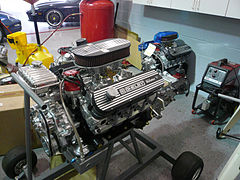
The Ford GT40 is a 1960s high-performance endurance racing car designed and built for and by the Ford Motor Company "Ford GT" project, an effort to compete in European long-distance sports car races, against Scuderia Ferrari, which had won the prestigious 24 Hours of Le Mans race from 1960 to 1965. Around 100 cars have been made, mostly as 4.7 litre "289" V8 mid-engined sportscars, some sold to private teams or as road legal Mk.III cars. Racing started in 1964, with Ford winning World Championships categories from 1966 to 1968. The first Le Mans 24h race win came in 1966 with two 7.0 litre "427" powered Mk.II prototypes crossing the finish line together, the second in 1967 by a 7.0 litre highly modified US-built Mk.IV "J-car" prototype. Considered too fast, a rule change from 1968 onwards limited prototypes to 3.0 litre Formula 1 engines, yet the private JW "Gulf" team collected additional Le Mans wins in 1968 and 1969 with the very same "old" Mk.I GT40 sportscar, still allowed with up to 5.0 litre engines when at least 25 had been made.

The AC Cobra, sold in the United States as the Shelby Cobra and AC Shelby Cobra, is a sports car manufactured by British company AC Cars, with a Ford V8 engine. It was produced intermittently in both the United Kingdom and later the United States since 1962.

Carroll Hall Shelby was an American automotive designer, racing driver, and entrepreneur. Shelby is best known for his involvement with the AC Cobra and Mustang for Ford Motor Company, which he modified during the late 1960s and early 2000s. He established Shelby American in 1962 to manufacture and market performance vehicles. His autobiography, The Carroll Shelby Story, was published in 1967.

The Aston Martin DB7 is a car that was produced by British luxury car manufacturer Aston Martin from September 1994 to December 2004. It was designed by Ian Callum and Keith Helfet as a grand tourer in coupé and convertible bodystyles. The prototype was complete by November 1992 and debuted at the Geneva Motor Show in March 1993. The six-cylinder DB7 was positioned as an "entry-level" model below the hand-built V8 Virage introduced a few years earlier. This model was the most-produced Aston Martin automobile up to that point in time, with more than 7,000 built before it was replaced by the DB9 in 2004.
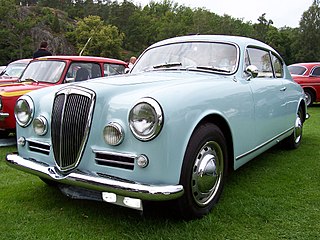
A grand tourer (GT) is a type of car that is designed for high speed and long-distance driving with performance and luxury. The most common format is a front-engine, rear-wheel-drive two-door coupé with either a two-seat or a 2+2 arrangement. Grand tourers are often the coupé derivative of luxury saloons or sedans. Some models, such as the Ferrari 250 GT, Jaguar E-Type, and Aston Martin DB5, are considered classic examples of gran turismo cars.

The Ferrari 250 GTO is a grand tourer produced by Ferrari from 1962 to 1964 for homologation into the FIA's Group 3 Grand Touring Car category. It was powered by Ferrari's Tipo 168/62 Colombo V12 engine. The "250" in its name denotes the displacement in cubic centimeters of each of its cylinders; "GTO" stands for Gran Turismo Omologato, Italian for "Grand Touring Homologated".

The Shelby Mustang is a high-performance variant of the Ford Mustang built by Shelby American from 1965 to 1967 and by the Ford Motor Company from 1968 to 1970.

The Ferrari 250 is a series of sports cars and grand tourers built by Ferrari from 1952 to 1964. The company's most successful early line, the 250 series includes many variants designed for road use or sports car racing. 250 series cars are characterized by their use of a 3.0 L (2,953 cc) Colombo V12 engine designed by Gioacchino Colombo. They were replaced by the 275 and 330 series cars.

The Shelby Daytona Coupe is an American sports-coupé. It is related to the Shelby Cobra roadster, loosely based on its chassis and drive-train developed and built as an advanced evolution. It was engineered and purpose built for auto racing, specifically to take on Ferrari and its 250 GTO in the GT class. The original project had six Shelby Daytona Coupes built for racing purposes between 1964 and 1965, as Carroll Shelby was reassigned to the Ford GT40 project to compete at the 24 Hours of Le Mans, again to beat Ferrari in the highest level prototype class. With the Shelby Daytona, Shelby became the first American constructor to win a title on the international scene in the FIA International Championship for GT Manufacturers in 1965. In 2014, the first Cobra Daytona Coupe became the first vehicle recorded under a U.S. federal program for documenting historically important national treasures.

Shelby American, Inc. is an American high performance automobile company founded by driver Carroll Shelby. The Shelby American name has been used by several legally distinct corporations founded by Shelby since his original shop in Venice, California began operation in 1962. The current iteration is a wholly owned subsidiary of Carroll Shelby International, Inc., a holding company formed in 2003. Carroll Shelby International's other wholly owned subsidiary is Carroll Shelby Licensing, which licenses the name and trademarks associated with Shelby to other companies. Shelby American was the first automobile manufacturer in the state of Nevada. Shelby American manufactures component automobiles, including replicas of the small-block and large-block AC Cobras, the Shelby GT350 and the GT500 Super Snake. Since 2005, Shelby American has released new models each year.
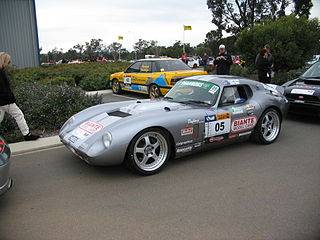
The Daytona Sportscar is an Australian built reproduction of the Shelby Daytona coupé from 1964. It was built by Richard Bendell, designed by Ross Holder and the chassis builder was Michael Borland. So far eight have been built, by Victorian race car builder Borland Racing Developments, with the first car built in 2001. It has competed in several Australian tarmac rallies since, including Targa Tasmania and Targa West.
Daytona Coupe may refer to:
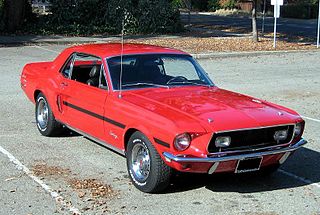
In mid-February 1968, the California Ford Dealers began to market a factory-built, limited-edition Mustang, called the GT/CS, or "California Special". The hope was for a targeted production run of 5,000; however, only 4,118 were made, including 251 units that were remarketed in Denver, Colorado, as "High Country Special '68". Production ran for only 5.5 months from mid-February 1968 to early August 1968. Today, classic car collectors consider these cars to be very desirable.
Ford Mustang variants are the various versions of the Ford Mustang car, modified either by its manufacturer Ford Motor Company or by third-party companies. Ford and several third-party companies have offered many modified versions of the highly popular Mustang since its creation in 1964 in order to cater to specific portions of the marketplace outside of the mainstream. High-performance enthusiasts seek more powerful, sharper handling, sports cars such as the Shelby Mustang, the Ford Mustang Mach 1, and variants made by Roush Performance and Saleen, while collectors and purists seek limited production and alternate or nostalgic styling, such as is commonly found on many commemorative editions. Still, others were made purely for experimental concepts such as the McLaren M81 and the Ford Mustang SVO, which later influenced production model design. Most variants include both performance upgrades, and unique cosmetic treatments that are typically minimal to maintain the familiar appearance of a stock Mustang. Although most of these Mustang variants were aimed at enthusiasts, an exception was the Special Service Package which was designed specifically for law enforcement. Race variants include the FR500, Boss 302 and Boss 429.
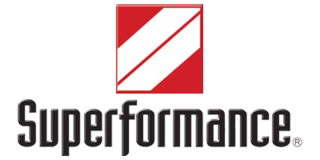
Superformance LLC is an American automobile company that builds, designs, develops, engineers and markets sports cars, related performance components and full replicars. The company was founded as "Superformance International Inc." by Hi-Tech Automotive Ltd. in 1996. Today, Superformance has 15 authorized dealers in the United States and 6 international dealers. SPF cars are sold as "turnkey-minus replacers". In December, 2005 Hi-Tech Automotive transferred the ownership of its subsidiary, Superformance, to American Hillbank Automotive Group, which is a privately owned business of American entrepreneur Lance Stander. Hi-Tech Automotive continue to build Superformance cars at its plant in Port Elizabeth, South Africa.
Peter Elbert Brock is an American automotive and trailer designer, author and photojournalist, who is best known for his work on the Shelby Daytona Cobra Coupe and Corvette Sting Ray.

The fifth-generation Ford Mustang, is a two-door four-seater pony car manufactured and marketed by Ford from 2004 to 2014, for the 2005 to 2014 model years — carrying the internal designation S197 and marketed in coupe and convertible body styles. Assembly took place at the Flat Rock Assembly Plant in Flat Rock, Michigan. The fifth generation began with 2005 model year, and received a facelift for the 2010 model year.

Hi-Tech Automotive is a low volume car builder and design house located in Port Elizabeth, South Africa. Most of the vehicles produced are exported, notably to the US and UK. The main distributor of the cars built by Hi-Tech is Superformance. In December 2005, Hi-Tech Automotive transferred the ownership of its subsidiary, Superformance, to the Hillbank Automotive Group, which is privately owned by Lance Stander.

The sixth-generation Ford Mustang (S550) is a pony car that was manufactured by Ford from 2014 until 2023. In departure from prior Mustang models, the sixth-generation Mustang included fully independent rear suspension on all models, as well as an optional 2.3L EcoBoost turbocharged and direct injected four-cylinder engine. The Mustang was introduced as a 2015 model year vehicle, marking the fiftieth anniversary of the Ford Mustang, which was revealed as a 1965 model year vehicle on April 17, 1964.
Neri and Bonacini, also known as Nembo, was a small carrozzeria and mechanic shop based in Modena, Italy, active from the late 1950s to around 1967. Founded and run by Giorgio Neri and Luciano Bonacini, the shop worked on and produced bodies for Ferrari, Lamborghini and Maserati road and race cars, both in an official capacity for those manufacturers and for private owners. Their best known projects are the Ferrari 250 GT-based Nembo spiders and the Lamborghini 400GT Monza. Neri and Bonacini also designed a car under their own name, the Neri and Bonacini Studio GT Due Litri. Two prototypes of this car were made between 1966 and 1968 but it never entered series production. The shop closed around 1967 when Bonacini went to work for De Tomaso and Neri started his own shop, Motors-World-Machines (MWM).








